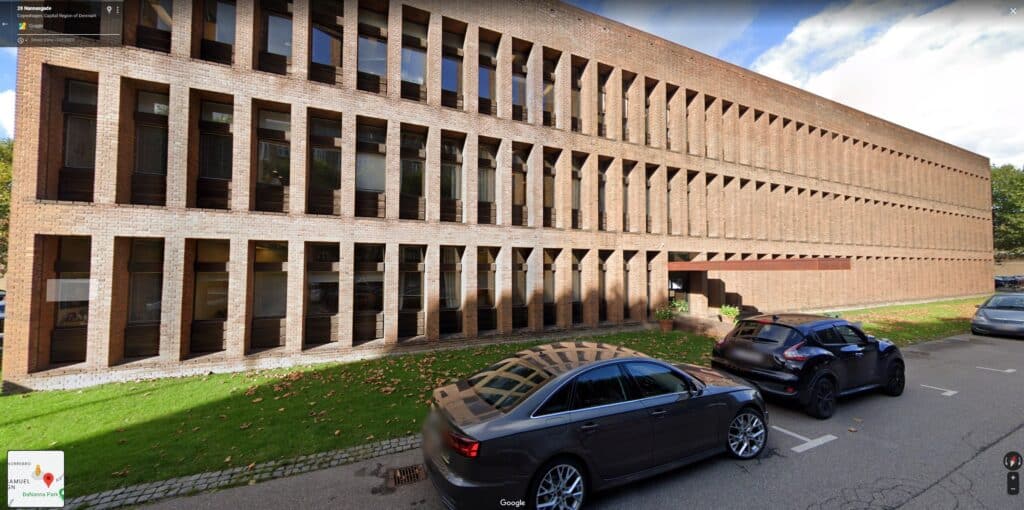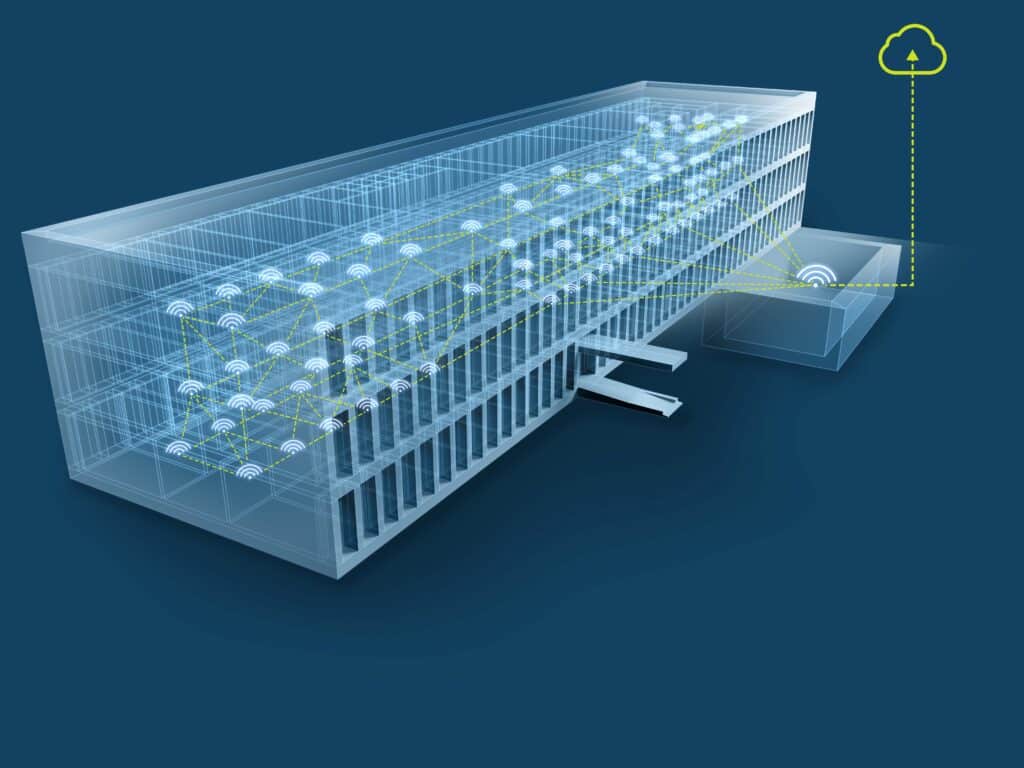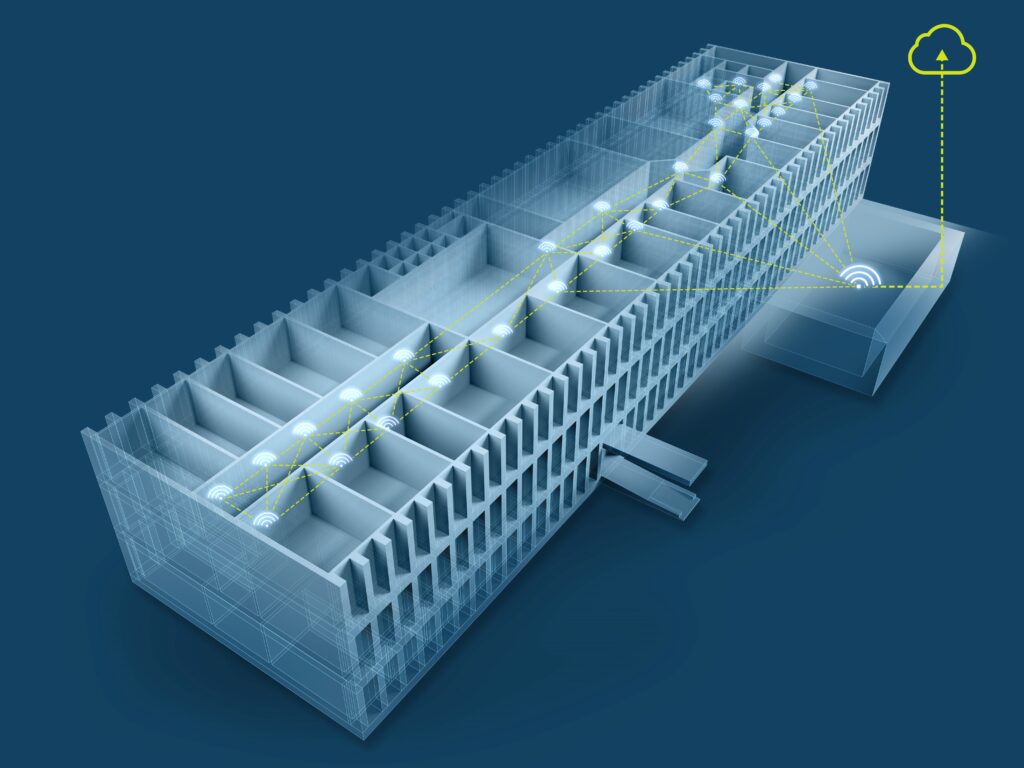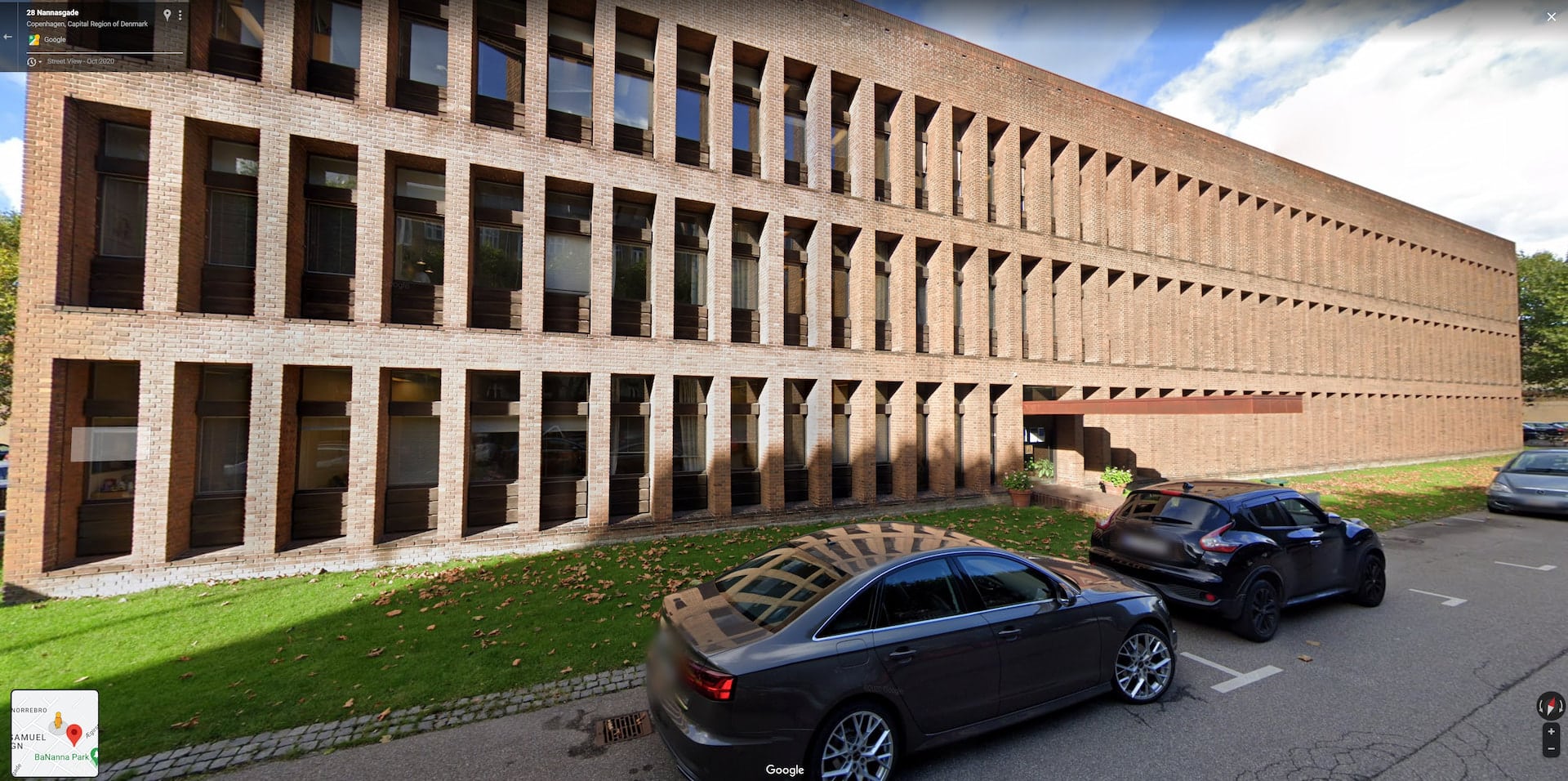
Think of Smart Buildings and you probably picture brand-new offices equipped with all the latest innovations in building automation. But conventional, low-tech buildings can also benefit from smart technology, thanks to advances in IoT and wireless communication. With NeoCortec network technology you can upgrade your building with a large sensor network in just a few hours.

There are many good reasons for making buildings smarter. Sensors provide data on which you can build useable insights, for instance to reduce heating cost, optimize ventilation or improve the overall energy efficiency of the building. Making a building smarter will make it more sustainable, while also reducing maintenance costs, optimizing the use of your spaces – and not least making the occupants of the building feel more comfortable and thus more productive.
However, facility managers are hesitant to introduce smart technology in older buildings because of the cost of cabling the building. This cabling is needed for the communication protocol to connect to the sensors. But with recent advances within IoT, you can manage without cables. Data can be sent wirelessly to the cloud or to be building management systems. And with the self-governing and extremely flexible NeoMesh network technology from NeoCortec it has become easier than ever.

As an example, it took only two and a half hours to install 93 temperature and humidity sensors in a 3-storey office building in central Copenhagen. After being installed in offices and corridors across the three floors, they automatically connected to each other due to the unique self-governing NeoMesh network protocol.
No main power cabling was needed as the sensors are battery powered. Immediately after installation, the sensors started to transmit measurement data via the central NeoMesh gateway to the cloud without any need for configuring the network. And, as the NeoMesh network is self-governing, data always finds a way from sender to receiver. The network nodes form an invisible spider’s web of communication channels, and if one communication path is blocked then data automatically just finds an alternative route to its destination.
The NeoMesh network technology creates a wealth of new opportunities for deploying state-of-the-art sensor and actuator systems in older buildings, significantly lowering the threshold of implementing Smart Building systems in existing buildings without a cable infrastructure, such as residential buildings and older office buildings. Any building can transform into a Smart Building, making it more sustainable, cost-effective, and more comfortable for its inhabitants.
Compared to other network technologies, NeoMesh has a number of advantages that makes it extremely simple to install, hassle-free to operate, and easy to change or expand. For instance, the only cabling needed is the cable powering the central gateway, which in this case is placed in the basement. And unlike network protocols like Zigbee or Bluetooth, the NeoMesh network can do without power-hungry repeaters needing mains power. Only one central gateway is needed to make the NeoMesh sensor network work and to connect it to the internet. All the rest, like connecting all nodes into a mesh and sending messages through the network, is automatically done by the network nodes themselves. Size of the building is not a problem as range is extended by adding more nodes to the network. Furthermore, as the complete sensor infrastructure is battery-powered with ultra-low power consumption, a NeoMesh network can function for years without need for battery change or other maintenance.
But before diving into the opportunities created by the NeoMesh network technology, let us take a closer look at the Copenhagen office building and the 93 sensors inside it.
Built in 1968 and located on Nannasgade in the Nørrebro district, it is about 2.000 square meters and about 30 small offices on each of the three floors. All inside walls defining the office spaces are made of bricks and are 35 cm thick, causing significant dampening of radio signals. There are about 100 radiators on each floor. The building’s basement, which has thick concrete walls, is displaced such that it is not directly underneath the building as shown on the illustration.
Creating robust wireless connectivity through bricks and concrete walls and across different floors were some of the factors the team from Nrlyze had to consider when deploying the NeoMesh network. Nrlyze is a Swedish tech company specialized in optimizing heating and ventilation systems in large buildings. CEO Lars Hansson and his team were approached by the owner of the Nannasgade office building to fix a costly problem: Connected to the city’s public district heating, the building had to live up to specific requirements regarding the correct temperature drop in the system.

Lars Hansson explains:
“To secure energy efficiency the district heating company requires the hot water that flows back into the building’s heating system to have cooled down to a fixed temperature level upon re-entering the district heating system. If the return water coming from your building is warmer than this level, you must pay extra. If it is cooler then it is the other way around: you can collect reward money from the district heating company. So, there is a lot of money to be saved if you can get as much as possible out of the hot heating water passing through the building.”
– Lars Hansson
The business of Nrlyze is to deliver advanced analytics for building owners and facility managers and automatically fine-tune their building control systems. Exact and continuous measurements are essential in this optimizing effort. Nrlyze is measuring temperature and humidity inside the building and correlating it with outdoor values to hydrostatically balance the radiators and to optimize the heating curve of the building’s heating system, for it to work as efficiently and economical as possible.
“At Nannasgade we have just finished our first round of measurements. These showed that the heating system was over-compensating, producing too much heat in some places, while producing too little in other. We have now done several adjustments based on our measurements, and everything works much better already. With one or two iterations we will be able to do an optimal setup of the system. When we are done, we will continue monitoring the Nannasgade heating system to secure that everything works as intended.”
– Lars Hansson
According to Lars Hansson, Nrlyze has chosen NeoMesh because it allows his team to quickly roll out a large sensor infrastructure. The network sets itself up and automatically establishes connectivity between the sensors. What makes it particularly easy is the fact that you only need one central gateway to collect all the sensor data and transmitting it from Nannasgade to the Nrlyze cloud platform. There is no need for repeaters or additional gateways to connect different parts of the network. Embedding the NeoMesh protocol in Nrlyze’s platform has been a smooth and successful process and Nrlyze will expand its collaboration with NeoCortec further.
According to Lars Hansson, there is a huge potential for a flexible, self-governing wireless network like NeoMesh when it comes to Smart Building and Smart City applications. Cato Skibsted Fagermo, head of sales at NeoCortec, agrees:
“Offices as well as residential properties can benefit from becoming smarter through sensor and actuator technology connected wirelessly. Heating and humidity can be controlled more efficiently, and air quality can be monitored in order to increasing the user experience of people in the buildings. Now you can equip all radiators in your entire buildings with smart thermostats. Also, in office buildings you can use it to book meeting rooms or optimize cleaning according to how much each office or meeting room has been used. There are endless possibilities, as long as you have a flexible wireless network in place.”
– Cato Skibsted Fagermo
Cato Skibsted Fagermo emphasizes the easy installation of NeoMesh. When removing cables from the equation, complex, costly, and time-consuming installation is not needed. Furthermore, office staff or apartment residents will not be disturbed more than a minute or two during installation.
Moreover, upgrading the building to become smart can be done incrementally. You can add one smart functionality at a time rather than everything at once. This means there is a lower investment threshold for the building owner as he only has to pay for what provides value for him.
Also, according to Fagermo, it is easy to cover large buildings with a NeoMesh network as it is extremely scalable and does not need additional gateways or repeaters to cover even very large areas as long as there is sufficient node density in the network.
“With NeoMesh, NeoCortec is significantly lowering the Smart Building threshold. We are offering a cost-effective, easy-to-install wireless infrastructure that can support a wide variety of use cases. With NeoMesh eliminating major issues regarding cost and inconvenience, there is no reason to hesitate: Installing Smart Building tech has never been easier.”
– Cato Skibsted Fagermo
| No cables needed | The only part of NeoMesh that needs mains power is the central gateway connecting the network to the IP world |
| Easy installation | Easy to change |
| Self-governing and self-healing | Easy to extend |
| Battery-powered, with ultra-low power consumption | Extreme scalability |
| The complete network infrastructure is battery-powered | Can run on wide variety of transceivers |

